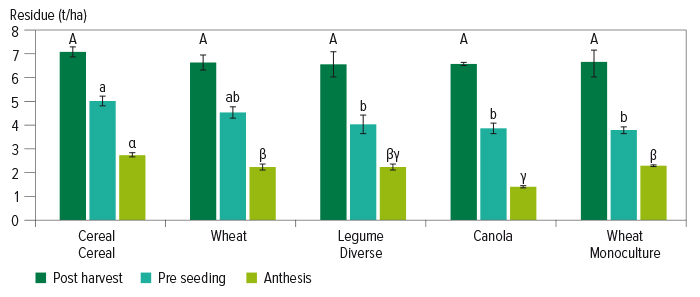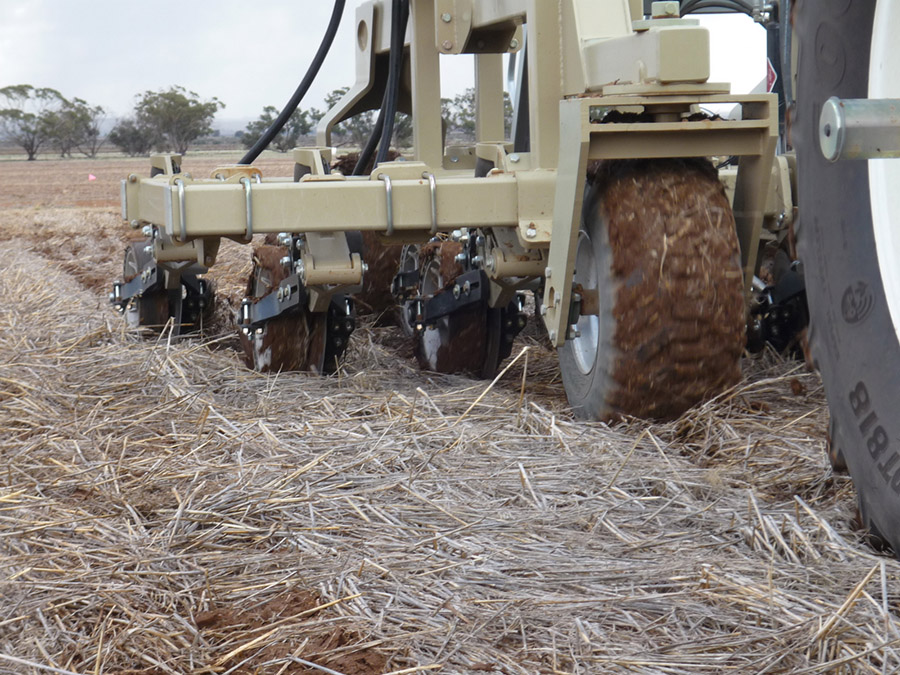Key points
- Crop residue retention is challenging but essential in water-limited, erosion-prone growing environments
- Residue management can aid moisture conservation, reduce erosion and improve water infiltration, as well as provide nutrient cycling benefits to the crop system
- The negative effects can be minimised by considering all aspects of the system, from crop agronomy through to machinery and guidance set-up and livestock management on stubble
Increased soil moisture, reduced wind erosion and run-off, lower evaporation and higher infiltration rates are just some of the benefits of retaining residue in no-tillage systems – but refining residue management to achieve this remains a challenge.
Improving residue management was one of the many aims of the GRDC-invested Western Australian No-Tillage Farmers Association (WANTFA) long-term trial that ran from 2006 to 2019.
“The long-term trial has generated a unique data set to be able to really start teasing apart the challenge of residue management and to provide some solutions,” says University of Western Australia Associate Professor Ken Flower, who has been involved in the work from the beginning.
Residue generates complex interactions in farming systems – for example, it influences plant establishment, herbicide efficacy, soil water dynamics, soil and air temperature changes and can even increase frost severity in some situations.
While the benefits of retaining residue are being seen by growers with the adoption of no-tillage farming, it is hoped that continuing developments in machinery guidance and new herbicide technology will enable more widespread and sophisticated forms of residue retention in Australian cropping systems.
The WANTFA trial comprised four rotational treatments and a continuous pasture. The rotational treatments were:
- a three-year rotation with cereals only and maximum residue retention;
- a diverse rotation (cereal/legume/canola with maximum residue retention); and
- a wheat monoculture with maximum residue retention and a grower rotation – cereal/cereal/break (legume or fallow) – with lower residue retention.
Windrow burning for weed control was practiced on half plots in the rotations with maximum residue retention and whole plots in the grower rotation.
Amount of residue
It has been learnt from the no-till trial that the crop type influences residue amount, with cereal-dominant rotations generating the most residue.
The amount of residue in a no-till farming system was found to vary throughout the year, ranging from the highest levels at harvest (which could be as much as six to seven tonnes per hectare) to the lowest at flowering and before the next harvest.
“Residue amount depends on biomass production and the decomposition rate driven by microbial activity, which is highly related to rainfall and temperature,” Dr Flower says.
“Of course, more rainfall means more crop growth and residue production, but dry summers mean low levels of decomposition.”
Figure 1 shows the mean amount of crop residue after harvest, before seeding and at anthesis of the following crop over the period 2013–18.
Figure 1: Mean amount of crop residue remaining after harvest and before seeding and anthesis of the next crop (2013–18) in the cereal and diverse rotations and monoculture wheat with retained residue. Different upper-case letters show significant differences between crop residues measured post-harvest, lower-case letters compare residues pre-seeding and Greek letters at anthesis (P≤0.05). Bars show ± standard deviation (n=3).

Source: WANTFA
Before seeding, the cereal rotation had the most residue remaining (5 tonne per hectare), although this was not significantly different from that left by wheat in the diverse rotation.
The legume and canola in the diverse rotation and monoculture wheat were similar, leaving an average of 3.8 to 4t/ha at seeding.
At anthesis, when residue amounts were lowest, the cereal rotation maintained the most residue (2.8t/ha), which was significantly greater than wheat in the monoculture and diverse rotation, which had between 2.2 and 2.3t/ha.
Canola left the least residue (1.4t/ha) at anthesis of the following wheat crop and this was probably because there was a legume before the canola, with residue from both of these crops generally breaking down much more than does cereal residue.
From the study, Dr Flower says the recommended optimum amount of residue is 3 to 4t/ha at seeding. “We found that if this amount was exceeded, usually after good or high-yielding years, the residue load sometimes reduced subsequent crop yields.
Therefore, management of residue at seeding is particularly important and we recommend more research to improve our seeding and residue management systems.
Burning effects
Windrow burning was found to reduce crop residue levels by 40 to 60 per cent compared with spreading the residue. This reduction in residue had negative effects on the following crop in dry years, especially when residue levels were already low for crops such as canola, but had positive effects on following crops with high cereal stubble loads still remaining in wet or good growing seasons. Combining burning with fallow reduced crop residue to about 1t/ha on average.
From this finding we recommend that care should be taken to maintain reasonable residue levels when using both windrow burning and fallow, particularly in drier areas or following dry seasons.
Also, under dry conditions, early establishment of wheat was markedly reduced when following a canola crop, compared with wheat after cereal.
“This did not appear to be linked with lower soil water at depth, caused by canola, and may be due to lower levels of ground cover with canola residue compared with cereals, although this needs to be investigated further,” Dr Flower says.
He also noted that species diversity in crop rotations, such as inclusion of legumes and canola, can reduce residue load. This may be an easier and more environmentally friendly means of managing residue amounts than a physical intervention.
Weeds and herbicides
“The management of weeds in crop systems is probably the biggest driver of residue management, alongside seeder blockages,” he says.
The diverse rotation and monoculture wheat treatments generally had the highest weed dry mass. Although canola was effective in reducing weed dry mass in the diverse rotation, poor weed control in the legume phases contributed to overall high weed biomass.
High residue amounts also had an effect on herbicide efficacy and research showed that some herbicides were more suited to systems with large amounts of residue retained than others.
Ongoing development of new herbicide and crop packages clearly have a role in no-tillage farming systems, and it is important to understand their efficacy in different residue situations.
“Even a rotation of different cereal crops, which allowed Clearfield cultivars and herbicides to be used, provided better weed control than monoculture wheat, especially when combined with windrow burning.”
Diseases
Levels of root lesion nematode and Pythium increased most in the pasture and diverse rotations. The combination of canola and wheat, along with susceptible chickpeas, appeared to favour root lesion nematode in the diverse rotation. In contrast, fallow and lupins in the farmer rotation appeared most effective at reducing disease.
By contrast, there was greater Rhizoctonia and Fusarium in the soil following cereals in general, compared with canola, chickpeas and fallow. However, this beneficial break crop effect appeared to be short-term.
The differences in disease host status between crop types and even varieties mean that growers require up-to-date information on the host status if rotations are going to be effective in reducing a broad range of plant-parasitic nematodes and pathogens in soils with no-tillage.
Chemistry
Of the main soil chemical constituents measured (organic carbon, total nitrogen, phosphorus, potassium and sulfur), soil sulfur declined most, from a site average of 10 milligrams per kilogram to 4mg/kg at zero to 10 centimetres.
Soil organic carbon over the 12 years of the trial was similar, to slightly lower, at the end. By contrast, total nitrogen increased slightly over the 12 years, as did soil phosphorus. Soil sulfur was highest in the diverse rotation, which had sulfur fertiliser applied to canola.
Stubble spread, removal and seeding access
“The poor uniformity of residue spread behind harvesters is an issue when considering controlled-traffic systems – as higher levels of residue were found directly behind the harvester than at the mid or edge of the cutting front,” Dr Flowers says.
Crop emergence and yield was reduced when cereal residue exceeded 3 to 4t/ha, with the negative effect being greater directly behind the harvester. This effect was largely with cereal residue. Similar amounts of other residue types – for example canola and legumes – had no negative effect on crop establishment and yield.

NDF single-disc planter seeding canola into knife-rolled Swan oat/vetch cover crop in the diverse rotation. Photo:WANTFA
Uneven distribution of residue behind the harvester, over a number of years, also affected soil chemical composition (organic carbon, total nitrogen, phosphorus, potassium and sulfur), with higher concentrations and pH usually where more residue was left directly behind the harvester.
“A potential problem with poor spread in controlled-traffic systems is the creation of zones of higher and lower nutrients, which is made worse by windrow burning,” Dr Flower says.
“From this work we would encourage further research and industry engagement on stubble spread behind harvesters, especially as the cutting width of harvesters increases over time.”
New Stubble Management Guide
A new GRDC-supported Stubble Management Guide for WA will soon be available which combines international and local research on the impact of stubble on cropping systems and presents information and grower case studies on the best ways to manage stubble to achieve the benefits of residue retention.
Moving to a complete no-till/stubble retention system can take time and there is no one rule to suit all farming systems. Each grower must weigh up the options and choose the practices that will suit their enterprise.
More information: Dr Ken Flower, 0417 952 081, ken.flower@uwa.edu.au

























































